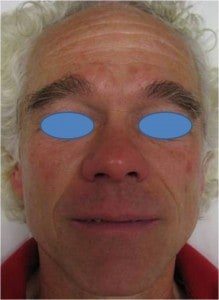Photo Gallery
Intense Pulsed Light (IPL) Photorejuvenation
 Before
Before
 After
After
Intense Pulsed Light, also known as fotofacial involves the administration of a broad spectrum of wavelengths of light to the skin. Because this technology delivers light of many wavelengths, it is technically not a laser. Intense pulse light (IPL) treatment is one of the most effective methods of treating sun-damaged skin, blood vessels, age/sun spots, the redness of Rosacea, permanent hair reduction, scars, stretch marks and warts. Different filters can be used to target specific components of the skin including brown pigment (melanin) in the skin and hair follicle, and the red hemoglobin within blood vessels. A series of 3 to 5 treatments at approximately 4 week intervals, is usually required to achieve the desired results.
Advantages of IPL
IPL is a non-ablative procedure, meaning it does not damage the superficial layer of skin. Unlike ablative treatments such as CO2 laser resurfacing, treatment with the IPL is associated with minimal (essentially zero) down-time. Because the IPL is non-ablative, however, this procedure does not address deeper scars and wrinkles.
Possible Risks and Complications
Although treatment with the IPL is generally very well tolerated, temporary redness, swelling, crusting, itching or blistering of the treated skin can occur. The swelling and redness that occur following IPL treatment usually subside within 24 hours, while any bruising that develops may take 7-10 days to resolve. Permanent hair loss may occur in treated areas. Patients can apply makeup immediately after treatment. Work
Description of the Procedure
To protect your eyes from the intense light, you will have your eyes covered with protective goggles. A thin layer of gel will be applied to the treatment area to ensure even distribution of the light. A smooth, flat, crystal is placed gently against the skin. You will feel a warm, brief, snapping sensation on the treatment area and a bright flash of light that may startle you. The treatment itself takes approximately 15-30 minutes, depending on the size of the area. Numbing the skin with topical anesthetic prior to treatment is strongly recommended, as it will make the procedure more comfortable.
Immediately following the laser treatment, swelling and redness are common and should fade over several hours. Brown lesions will darken and peel after 5-7 days.
Aftercare Instructions
- A bland moisturizing lotion or cream (e.g. Aveeno, Cetaphil, Eucerin, Cerave), and/or aloe vera gel should be applied to the treated areas 2 to 3 times a day as long as discoloration and peeling are present.
- You may use cover-up makeup if you are bothered by the post-treatment appearance.
- Do not rub, scratch, pick at, or over-irritate the treated area
- Avoid bleaching creams, Retin-A, glycolic acid, and other irritating products until the skin returns to normal (2 weeks or longer after IPL treatment).
- If the area becomes painful, blistered, burned or develops signs of infection, please call the office immediately.
- Avoid or minimize exposure to the sun until redness and peeling have resolved (2-3 weeks is recommended).
- A sunblock of SPF 30 or higher should be applied daily to prevent pigmentation changes until the treated area has healed. If any areas have scabs or are oozing (rare), dilute vinegar compresses should be applied twice daily, using 1 teaspoon of table vinegar per cup of water.
Ask your dermatologist whether you would be a good candidate for IPL treatment.
